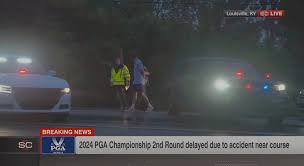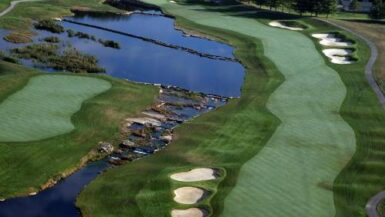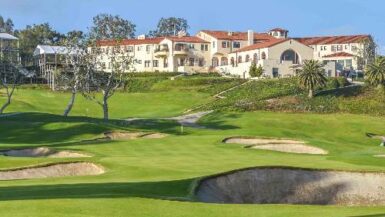
You meet a wealth of Great Friends of Golf, (yes, capital G, F, and G), when you become a golf writer, and one of those is the PGA of America’s Bob Denney. Classy, kind, intelligent, and genuine: when people ask me why I like hanging out with golf writers and golf people as much as I like hobnobbing with my entertainment law practice clientele, a guy like Bob is Exhibit A.
So Bob and I were having a Twitter discussion, and he mentioned that, one reason he thought Oak Hill was truly great was because while it wasn’t set up like a U.S. Open course, it still played like a U.S. Open, (meaning that winning scores were low). Specifically he Tweeted, “Proud Oak Hill CC member stat: Just 10 players have finished under par in all medal play championships on the East Course. #FinalMajorExam”
I wrote back that I wasn’t sure that was a good thing, and Bob responded that, “It translates that Oak Hill did not have to be set up like a U.S. Open to be challenging through the years.”
With the greatest respect to my colleague – older and wiser – on this one, as we say in law practice, I respectfully dissent. I’m not so sure the PGA of America doesn’t set up some of the former U.S. Open venues like old 1980s-style U.S. Opens, and I’m certain that harder is not better, because you get fewer birdies, (which means less excitement for the fans), and a “restrictor plate” effect on the field where the winner is the guy who makes the fewest mistakes rather than the guy who goes out there and charges to victory.
Let’s start with what Oak Hill is: it’s an old classic Donald Ross course, (1901), that is somewhat controversial because of changes by golf architects George and Tom Fazio that both homogenized the layout, and made it needlessly tough. It boasts the distinction of being the only course in the U.S. to host, “all six of the men’s majors that don’t have a permanent home: the U.S. Amateur, U.S. Open, PGA Championship, U.S. Senior Open, Senior PGA, and Ryder Cup.”
Okay, fine, but which came first? The chicken or the egg? Is it good because it hosts majors or does it host majors because it’s good? Remember, the U.S. Supreme Court is always right because it’s the last place you can go, not vice-versa…
Anyway, in 1956 Dr. Cary Middlecoff won the first U.S. Open at the East Course with a score of 281, (1-over). He won 6,000 USD in prize money.
Since then it’s hosted two more U.S. Opens and two PGAs, with mixed results as to the winners. First, Lee Trevino broke through there with his first major victory in the 1968 U.S. Open, (5-under 275, at that time tied for the U.S. Open aggregate record, and was the first person card four rounds in the 60s in a U.S. Open – two important factoids which have shaped Oak Hill’s architectural destiny for decades since).
“I used to be a Mexican, but now that I’m makin’ money, I’m gonna be a Spaniard,” Trevino joked hysterically.
Then Curtis Strange became only the sixth man in history to win back-to-back U.S. Opens when he slaughtered Nick Faldo in a playoff by four shots in 1989. (The others, for those of you scoring at home, are Hogan in ’50-’51, Ralph Guldahl ’37-’38, Bobby Jones in ’29-’30, John J. McDermott in ’11-’12, and Willie Anderson in ’03-’04-’05.) Strange and Faldo shot 2-under 278 to make the playoff. The only other thing remarkable about that PGA Championship was four hole-in-ones recorded at the par-3 sixth hole in a period of one hour and 57 minutes.
“The pin must have been too easy on six,” said one rocket scientist.
The two PGAs are as far apart in historical impact as you can get. In 1980 Jack Nicklaus completed the rare “US Open-PGA Championship” sweep by dusting the field by seven shots, (6-under 27), until that time only the third man ever to do it, (Gene Sarazen in 1922, and Ben Hogan 1948, hat tip Dan Jenkins for the info…but remember, Geno and the Wee-Bantam-Hawk-Iceman won their PGAs in match play…).
But it’s also well documented that everyone except Jack and Oak Hill members hated what Tom and George Fazio did to the course to toughen it up after what happened last time a major was there – the Merry Mexican Jumping Bean’s record-tying performance. As Jenkins put it, “Everyone else needed a rabies shot. They didn’t like four holes being toughened up. And they didn’t like reshaped greens that kept shots as far away from flags as possible.”
We’ve all seen it before, but we’re finally learning not to repeat our mistakes: the Fazios make courses tougher, but as Tom proved at Augusta National, they don’t make them better.
The PGA returned again in 2003 when unknown, unheralded, and until that time unaccomplished Shaun Micheel – winless in 163 previous PGA Tour starts – beat boring Chad Campbell by two, (3-under 277). Micheel’s currently residing in the “Where are they now?” file with Michael Campbell. I watched that 2003 PGA – what a snorefest. Even Brandel Chamblee called that tournament “not quite memorable.”
One reason why is because Oak Hill just doesn’t have a lot of character. Architecturally, it shows you nothing you haven’t seen before: narrow fairways, lots of thick northeastern rough, trees everywhere, (an estimated 75,000 over 355 acres when Ross designed the two courses), elevated greens, and penal “five o’clock-seven o’clock” greenside bunkering – lather, rinse, repeat. The burn that winds its way through the course, Allen’s Creek is nowhere near as famous as Swilcan or Barry Burn. The two par-5s are all but unreachable for everyone, there’s only two par-4s under 400 yards, so birdies – and therefore excitement – will be at a premium.
So I ask the question everyone is thinking: Where is the character in Oak Hill? And I get the answer everyone knows and hates: The trees. Even their own historian, Sal Maiorana said it: “The trees dominate the landscape…and are a treacherous detriment to one’s scorecard.”
Or as runner up Tom Kite said, “Every time I missed a shot I got killed.”
That’s not golf. If I want to see guys hit punch shots from out of the pachysandra, the Japanese maples, and the willows while scraping pars and bogeys all day, I’ll go watch my entertainment lawyer buddies try their Sunday golfer act out on Forest Park in Queens – PASS!
Sometimes the PGA of America tries too hard to be the U.S. Open. In 2008 Oakland Hills got away from them. First, they choked all those beautiful fairway contours with rough, then they dried out the fairways and greens so they wouldn’t hold good shots. Had it not torrentially rained we would have had a flaccid, dry, boring PGA Championship that year, with likely a fluke winner. Instead Mother Nature – thankfully – intervened and Padraig Harrington held off a hard-charging, hard-luck Sergio Garcia with an absolutely epic 66-66 Sunday 33-hole finish over unconquerable Oakland Hills to win both the PGA and British Open in the same year.
That was electric, one of the best single-day performances in golf history, and we would not have seen that had it not rained because the PGA used “fast and firm” conditions to restrict scoring. We had a bloodletting for the first two days instead of a golf tournament.
In 2005 at Baltusrol we saw something similar. Baltusrol is one of the easier U.S. Open venues. It’s twice seen winners tie the aggregate scoring record, (Nicklaus and Janzen), and it surrendered two 63s in one day in 1980, tying the single round major scoring record.
And you know what? Hell didn’t freeze over.
But when the PGA Championship was held there in 2005, Phil won with 4-under 276, a higher winning score than both of the last two U.S. Opens. And that was on a rain-softened golf course. Look at how much more exciting, indeed historic Phil’s 66 to close at Muirfield was at this year’s British Open. The R&A let the guys play golf on Sunday, they didn’t care about what the winning score would be, and we got a finish for the history books. It was the complete opposite of what happened at the U.S. Open this year, when they tucked all the pins and the winner was the player who fell the least down the leaderboard on Sunday, not the golfer who soared the highest.
Time has proven that making any course harder, (including Oak Hill), has made it less enjoyable for everyone. Why don’t you just put a pride of hungry lions around the flags? For a final illustration, look what they called the 1995 Ryder Cup: Choke Hill.
When you make a golf course obscenely hard for a professional tournament by growing rough, not cutting down architecturally insignificant trees, and adding length, I ask again, (as I always do), Qui bono? Who benefits?
Golf doesn’t: it teaches poor architectural principles to people watching on TV. The golfers don’t: they end up looking silly or embarrassed or both. The fans don’t: they pay good green money to come to the finals of a national sporting event and get little to cheer about. It’s polite golf claps, not roaring on the pines. Look at last year – no one was bored by Rory’s Godzilla act that turned Ram-tough Kiawah Island into a Tonka toy.
How great would it be to see Phil Mickelson go back-to-back to close out the season and sew up a Player of the Year award? How great would it be to see Rory roar and return to dominating form? How heartwarming would it be to see a Westy or Luke Donald break through? Or to have free-wheeling, sweet-swinging Bubba Watson or Angel Cabrera add to their list of major titles? But we have just as much a chance of some off-brand journeyman pro winning here, the guy who makes the least mistakes, not the guy who goes out plays the best golf.
The PGA Championship has thirty-four winners who claimed it as their only major. In contrast, the U.S. Open has twenty-five, the British Open twenty-two and the Masters a mere eighteen. Look at this partial list of hunters who bagged their only big game trophy at the PGA: Jeff Sluman, David Toms, Shaun Micheel, Rich Beem, Mark Brooks, Steve Elkington, Wayne Grady, (WAYNE GRADY!), Bob Tway, Martin Kaymer, Y.E. Yang, (who dresses like he’s sponsored by Garanimals), and Jerry Barber. That’s not exactly a murderer’s row or a list of Hall of Famers. We stand just as much a chance of seeing a Bill Haas or Webb Simpson or (Heaven Forbid!) an octopus-pantsed Billy Horschel winning this week as we do a Padraig or Graeme McDowell or Adam Scott. Indeed, perhaps only Scott may the only “Go out there and sling it” major winner to come through next week.
So everyone put down the stimpmeter and slowly back away. Sometimes, you have to let the guys play golf for the title, not mince around on eggshells trying to avoid the minefield of unexploded double bogeys.
Will we have a great time? Of course we will. Is it a “classic parkland test”? Yes, but will Oak Hill shine through like a Winged Foot or Oakland Hills or Oakmont and be the star of the tournament? If history is any guide, probably not. People think it’s “good” because it hosts majors, but does it host majors because it’s really all that good? Tell me…could you recall one great hole at Oak Hill before this week came along? Will you afterwards? If Phil or Rory wins, maybe. But looking at its design, and set-up, it seems Oak Hill is more famous for holding majors than for the history that’s been written there. Are we really allowed to see the real Oak Hill with it being over grown with trees, rough, and super-model slim fairways? Set up the way it is – to be ludicrously hard – Oak Hill may be relying on its reputation for the glory of its fame rather than the character and other merits of its golf course.
This article also appeared at Cybergolf.com. Tune in all week for PGA Championship coverage.




